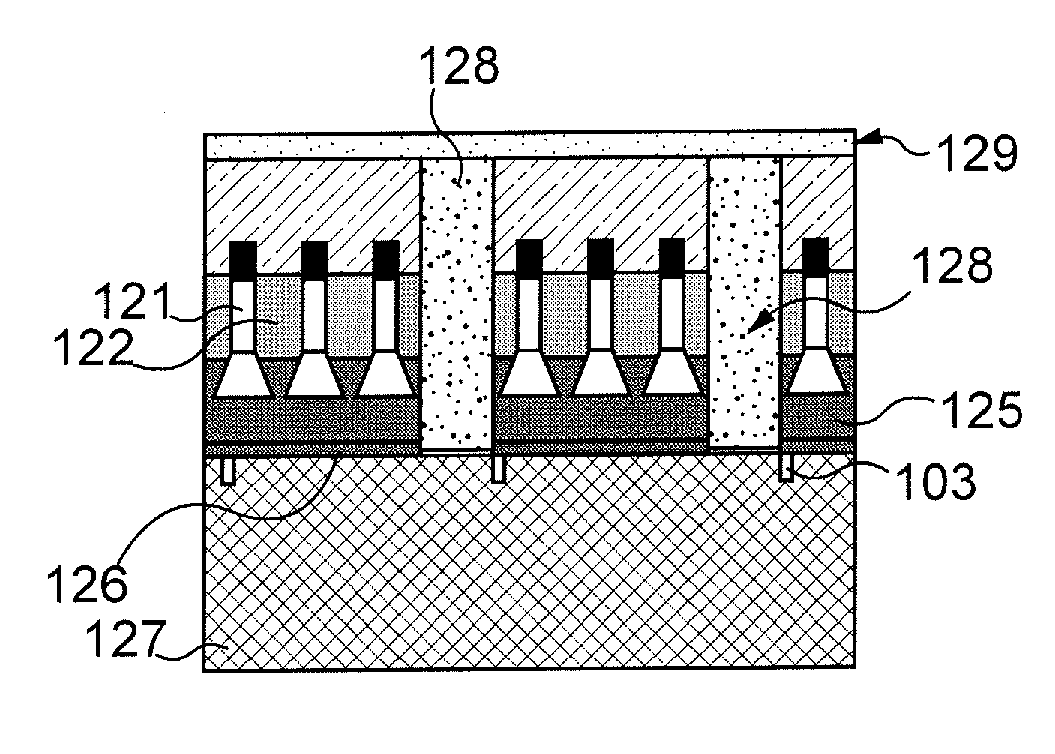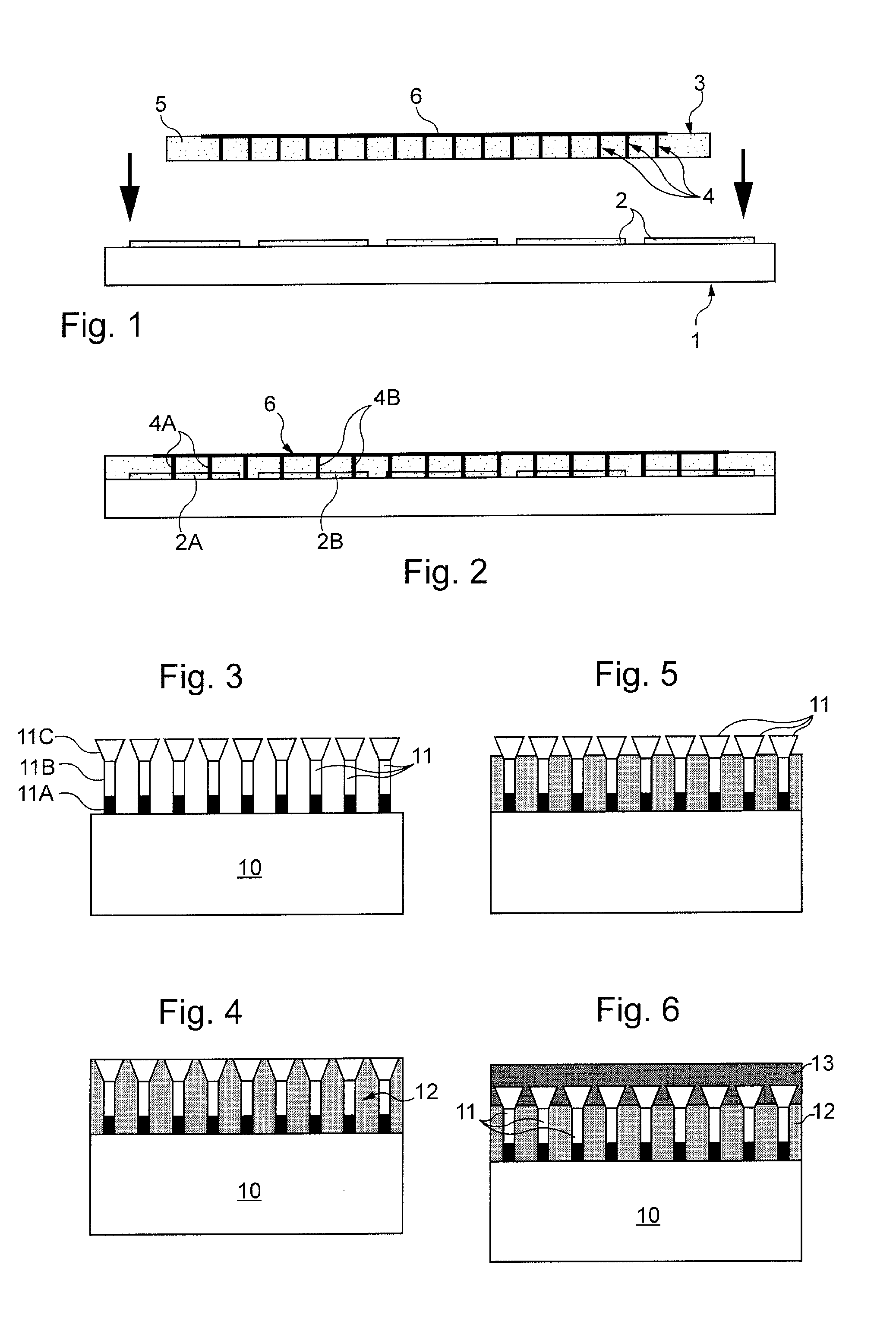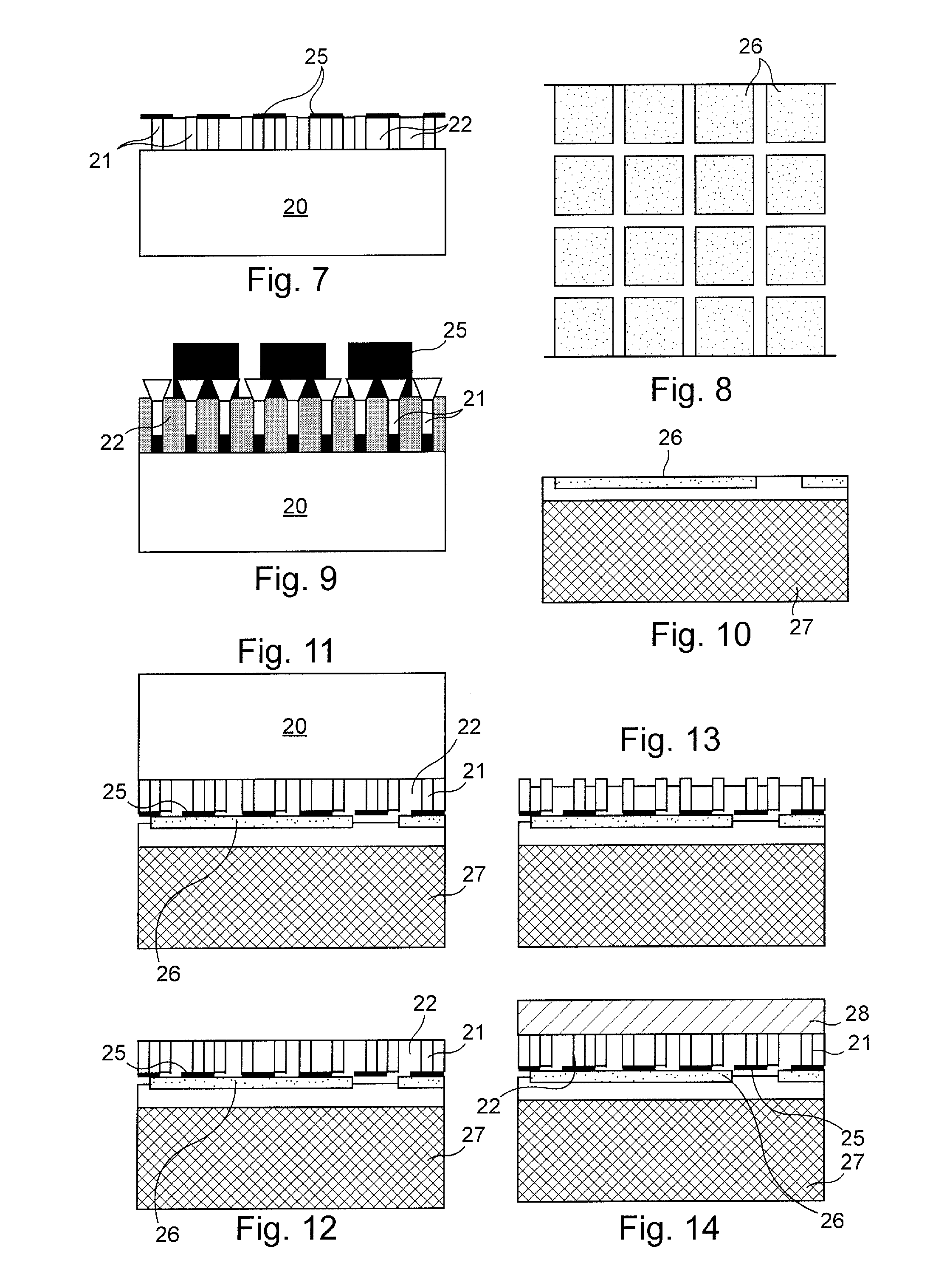A problem common to these two types of screen is the difficulty in combining high resolutions (many image points or pixels) with a small screen size (in order to reduce the cost).
In the case of LCD screens (in practice it is more precisely a matter of screens of the reflective LCOS (reflective “
Liquid Crystal On
Silicon” on
integrated circuit) type or of the transmissive LCD on glass type (notably marketed by the Kopin company), one of the main problems for the small pixels is controlling the state of the
liquid crystal between adjacent pixels.
In fact, the field lines created at the level of a pixel can affect the field lines of the adjacent pixels, generating interference at the level of these pixels.
In fact, the pixel electrodes in practice constitute steps with respect to the surface of the
active matrix; the fact that the emissive part is formed of
layers causes these steps to remain in this emissive part; in particular the conductive layer forming the counter-electrode opposite the pixel electrodes (in practice it is a matter of the layer by which the emissive part terminates) thus comprises steps, which constitute risks of short-circuit (at the location of the level changes, the
layers risk being interrupted and causing inadvertent contacts).
It is understood that this problem hampers the production of high-resolution (small pixel) OLED screens by causing the percentage of emissive surface to drop.
A second problem concerns with the use of
colored filters.
In fact, whether these are deposited directly on the
active matrix, or assembled with the active matrix, there is a loss of aperture related to the design rules in the first case, or related to the alignment precision in the second case.
This results in an additional limitation of the
active surface aperture.
A third problem concerns the extreme
fragility of the OLED layers, in particular with regard to impurities such as water for example.
Specific encapsulations are used but
aging problems nevertheless persist with this type of screen.
In addition to the above mentioned difficulties is the problem that, whatever technique is used (LCD or OLED), the possible presence of particles at the interface between the active matrix and the emissive layers generates risks of horizontal short-circuit between adjacent pixels (which is a crippling risk which considerably hampers the reduction of inter-pixel pitches and therefore the resolution).
1. The first approach consists, starting from a
solid substrate or from an epitaxial layer, in
etching structures of nanowires, conventionally by means of a nano-lithographic and
reactive plasma etching (ICP (
Inductively Coupled Plasma), RIE (Reactive Ionic
Etching), etc.) technique. This approach is notably described in the reference “InGaN-GaN
Nanorod light Emitting Arrays Fabricated by Silica Nanomasks”; Min-Tann Hsieh and Al, IEEE journal of
quantum electronics, Vol 44, pp 468-472, no. The
etching approach therefore makes it possible to obtain wires of nanometric size with, however, certain limitations which depend on the nature of the material, the lithographic and etching methods, . . . , the
advantage being that the orientation of the wires does not depend a priori on the crystalline orientation of the substrate.
2. The second approach consists in growing nanowires by
chemical vapor deposition using a method of the VLS (
Vapor Liquid Solidification) type which uses a generally
metallic catalyst (gold for example). The nanowires often grow in epitaxial relationship with the substrate. Because of this, the vertical nanowires are obtained for a particular orientation of the substrate. The position and the
diameter of the catalyst determine the position and the
diameter of the nanowires, which can be less than 10 nm. This technique has certain advantages: very large form factors, control of dimensions of the nanowires, of the
chemical composition and of the
doping along the wires. There are also growth solutions without catalysts used for the generation of nanowires of GaN and ZnO or of heterostructures based on these materials by MOCVD (
Metal Organic
Chemical Vapor Deposition) and MBE (
Molecular Beam Epitaxy) (see, in particular “High-Brightness Light Emitting Diodes Using
Dislocation-Free
Indium Gallium Nitride /
Gallium Nitride Multiquantum-Well
Nanorod Arrays”, Hwa-Mok et al, Nano Letters 2004, Vol 4, no.
It should be noted that the arrangement of the second electrode beside the nanowires results from the difficulty there is in integrating a conductive or
metal layer directly in the growth substrate of the wires (in fact it is not generally possible to implement a
doping sufficient to allow the formation of such an electrode) without harming the epitaxial growth performance of nanowires and / or the overall performance of the final device.
It is clear that the presence of these lateral electrodes is an obstacle to the obtaining of high-resolution screens taking
advantage of the virtual totality of their surface.
It is understood that the sets of nanowires are a source of
fragility, both during their manufacture and within the assemblies in which they participate, since they are connected to each other only by the intermediary of the circuits to which they are fixed by their ends; moreover, their fixing to the second circuits requires accurate positioning of the latter with respect to the first circuits.
The proposals of this document therefore involve complex and costly procedures.
 Login to View More
Login to View More  Login to View More
Login to View More 


